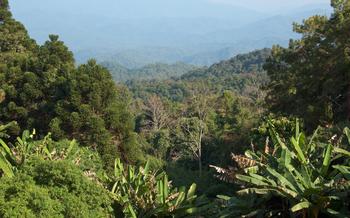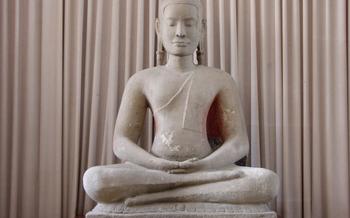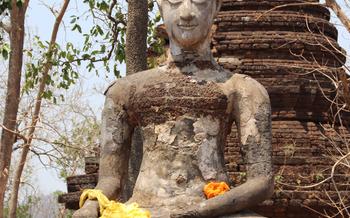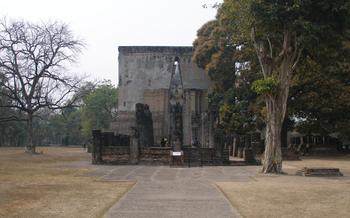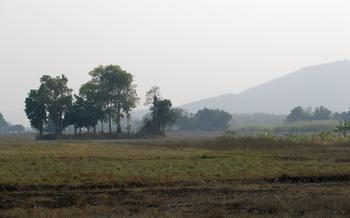
Wat Wang Nam Kheo
- History of Wat Wang Nam Kheo
- Location and Getting There
- Architecture and Design
- The Grand Buddha Image
- Other Notable Features
- Religious Significance
- Pilgrimage Site
- Local Beliefs and Legends
- Buddhist Teachings and Practices
- Cultural Importance
- Visitor Etiquette
- Photography and Videography
- Accessibility
- Nearby Attractions
- Insider Tip: A Serendipitous Encounter
History of Wat Wang Nam Kheo
Wat Wang Nam Kheo is a stunning Buddhist temple located in Phitsanulok, Thailand. Founded in the 19th century, it is renowned for its impressive architecture, serene atmosphere, and a majestic Buddha image. The temple was constructed under the patronage of King Rama IV and served as a royal monastery during that period. Its architectural style is a fusion of traditional Thai and European influences, resulting in a captivating blend of grandeur and spirituality. As a religious site, Wat Wang Nam Kheo holds immense significance for local Buddhists and plays a vital role in preserving and promoting Thai religious traditions and practices.
Location and Getting There
Wat Wang Nam Kheo is situated in the city of Phitsanulok, in the northern region of Thailand. The temple is conveniently located just a short distance from the city center, making it easily accessible for visitors. To reach the temple, you can take a tuk-tuk or a songthaew, which are local modes of transportation that are widely available in Phitsanulok. Alternatively, you can rent a bicycle or a motorbike to explore the city and its surroundings at your own pace. If you are traveling by car, there is ample parking space available at the temple for your convenience.
Architecture and Design
Wat Wang Nam Kheo is renowned for its intricate and distinctive architectural style, which exemplifies the fusion of multiple cultural influences. Visitors are immediately captivated by the temple's towering prang, adorned with delicate stucco patterns and intricate carvings. The prang, reaching towards the heavens, symbolizes the Buddha's journey to enlightenment and serves as a focal point for the entire temple complex.
The temple's ubosot, or ordination hall, is another architectural masterpiece. Constructed from gleaming white marble, the ubosot exudes an aura of purity and serenity. Its exterior is embellished with intricate bas-reliefs depicting scenes from the Buddha's life and teachings, while the interior boasts a collection of stunning murals and intricate woodwork. These murals, painted in vibrant hues, depict various episodes from Buddhist mythology, showcasing the temple's rich artistic heritage.
One of the most striking features of Wat Wang Nam Kheo is its elaborate viharn, or assembly hall. The viharn's roof, supported by an array of ornate pillars, is adorned with colorful ceramic tiles, creating a vibrant mosaic that catches the eye from afar. The interior of the viharn houses a collection of revered Buddha images, some of which date back centuries, each with its unique story to tell.
The Grand Buddha Image
At the heart of Wat Wang Nam Kheo lies its most revered treasure, the awe-inspiring Grand Buddha image. Towering over the temple grounds at an astonishing 37 meters, this colossal statue exudes an aura of serenity and grandeur. Crafted from shimmering gold and adorned with intricate details, the Buddha emanates an otherworldly presence that captivates visitors from afar.
The construction of this majestic image dates back to 1977, when a group of devoted monks and artisans embarked on a mission to create a symbol of faith that would inspire generations to come. Overcoming numerous challenges, they meticulously poured their hearts and souls into the project, ensuring that every inch of the Buddha's form was imbued with sacred beauty.
The Grand Buddha image holds immense significance for local Buddhists, who regard it as a representation of the enlightened one himself. They flock to the temple from far and wide to pay homage to this sacred icon, seeking blessings, guidance, and inner peace. To them, the Buddha is an embodiment of compassion, wisdom, and the path to liberation from earthly suffering.
Other Notable Features
In addition to the Grand Buddha image, Wat Wang Nam Kheo contains several other notable features that visitors should explore. The temple complex boasts a collection of smaller Buddha images, each with unique characteristics and significance. These images are arranged throughout the temple grounds, offering a diverse representation of Buddhist iconography.
The temple also houses an impressive collection of Buddha relics, believed to be fragments of the Buddha's remains. These relics are enshrined in a special reliquary within the temple, attracting pilgrims and devotees from around the region who come to pay homage and seek blessings.
Another notable feature of the temple is its intricate murals and paintings, which depict scenes from the Buddha's life and teachings. These murals adorn the walls of the temple's main hall and provide a glimpse into the rich artistic traditions of Thailand.
Finally, the temple grounds are home to a serene and tranquil pond, which adds to the temple's peaceful and contemplative atmosphere. Visitors can take a moment to relax by the pond, surrounded by lush greenery and the gentle sounds of nature, creating a perfect setting for reflection and meditation.
Religious Significance
Wat Wang Nam Kheo is a temple of utmost religious significance in Phitsanulok, Thailand. It is one of the most revered and sacred temples in the region, attracting numerous Buddhist devotees and pilgrims throughout the year. The temple is considered a center of spiritual devotion and holds a special place in the hearts of local Buddhists.
The Grand Buddha image, situated within the temple premises, is a focal point of religious worship and reverence. Devotees come to pay homage to the Buddha, offer prayers, and seek blessings. The temple also serves as a place of meditation and spiritual retreat for those seeking inner peace and tranquility.
Regular religious ceremonies, festivals, and events take place at Wat Wang Nam Kheo, further enhancing its religious importance. These events bring together the local community and provide opportunities for devotees to celebrate their faith and strengthen their spiritual connection.
Pilgrimage Site
Wat Wang Nam Kheo holds a significant position as a pilgrimage site for devout Buddhists from Thailand and beyond. Pilgrims from all walks of life flock to this sacred ground, drawn by its reputation for spiritual enlightenment and the presence of the revered Grand Buddha image. For many pilgrims, this journey represents a profound expression of faith and a chance to deepen their connection with the teachings of Lord Buddha.
The temple's serene ambiance and spiritual energy create an ideal setting for pilgrims to engage in meditation, prayer, and contemplation. Many pilgrims believe that visiting the temple and paying homage to the Grand Buddha image will bring blessings, good fortune, and protection. Some pilgrims even embark on extended stays at the temple, immersing themselves in spiritual practices and seeking guidance from the resident monks.
Throughout the year, Wat Wang Nam Kheo plays host to numerous religious festivals and ceremonies that attract a large number of pilgrims. These events provide an opportunity for pilgrims to come together, celebrate their faith, and participate in communal rituals. The temple's annual Buddha Day celebration, which commemorates the birth, enlightenment, and passing of Lord Buddha, is a particularly significant event that draws thousands of pilgrims from across the region.
Local Beliefs and Legends
Wat Wang Nam Kheo is steeped in local beliefs and legends that contribute to its mystical aura. According to one popular legend, the temple was founded by a revered monk who meditated on a nearby hill. During his meditation, he received a vision of a reclining Buddha and was instructed to build a temple on that spot. Another legend tells of a giant snake that once guarded the temple and protected it from harm. The snake is said to have disappeared into a nearby cave, leaving behind a footprint that can still be seen today. These legends add to the temple's allure, creating a sense of wonder and enchantment for visitors.
Buddhist Teachings and Practices
Wat Wang Nam Kheo is not only a place of worship but also a center for Buddhist teachings and practices. Visitors can learn about the fundamental principles of Buddhism, such as the Four Noble Truths, the Eightfold Path, and the concept of karma. The temple offers meditation classes for both beginners and experienced practitioners, providing a serene environment for spiritual development. Additionally, monks at the temple conduct regular chanting sessions, allowing visitors to immerse themselves in the sacred sounds and teachings of Buddhism. These practices contribute to the temple's spiritual significance, making it a place where visitors can deepen their understanding of Buddhist philosophy and find inner peace.
Cultural Importance
Wat Wang Nam Kheo holds immense cultural significance as a representation of traditional Thai culture and heritage. Its unique architectural style showcases intricate carvings and designs that reflect the country's rich artistic traditions. The temple serves as a venue for various cultural events, performances, and festivals throughout the year. These events attract both local and international visitors, providing an opportunity to experience Thailand's vibrant cultural heritage firsthand. The temple's significance extends beyond its religious role, making it a symbol of national pride and identity for many Thai people. It is a place where visitors can immerse themselves in the essence of Thai culture, appreciate its artistic expressions, and gain a deeper understanding of the country's diverse cultural heritage.
Visitor Etiquette
When visiting Wat Wang Nam Kheo, it is essential to be respectful of the religious significance of the site. Visitors should dress modestly and avoid wearing shorts, tank tops, or other revealing clothing. It is also customary to remove your shoes before entering the temple grounds.
When inside the temple, it is important to maintain a respectful demeanor. Avoid talking loudly or making noise that may disturb other visitors or disrupt the peaceful atmosphere of the temple. It is also considered disrespectful to point your feet at the Buddha image or to touch any of the Buddha statues.
If you wish to take photographs or videos inside the temple, be sure to ask permission from the monks or temple staff first. It is also important to be mindful of other visitors and to avoid taking pictures that may be intrusive or disrespectful.
By following these simple guidelines, visitors can help to ensure that Wat Wang Nam Kheo remains a sacred and welcoming place for all.
Photography and Videography
Photography and videography are generally permitted at Wat Wang Nam Kheo, but visitors should be mindful of the temple's sacred nature. It is important to respect the privacy of other visitors and avoid taking photos or videos that may be intrusive or disrespectful. Using flash photography or tripods may be restricted in certain areas of the temple, so it is advisable to check with the temple authorities before using any photography equipment. Visitors should also be aware of any signs or notices that may indicate restricted areas or specific guidelines regarding photography and videography. By following these guidelines and showing respect for the temple's sanctity, visitors can capture their memories without disrupting the peaceful atmosphere of the site.
Accessibility
Wat Wang Nam Kheo is generally accessible to visitors with disabilities, although there are a few challenges to be aware of. The temple grounds are mostly flat and paved, making it easy to navigate for those using wheelchairs or mobility scooters. However, there are a few steps leading up to the main temple building, which may require assistance for those with limited mobility.
The temple also provides accessible restrooms and ramps for easy access to all areas of the complex. Additionally, there are designated parking spaces for disabled visitors located near the temple entrance.
While the temple is accessible, it is important to note that the surrounding area may not be as wheelchair-friendly. The sidewalks in the vicinity of the temple are narrow and uneven, and there may be obstacles such as parked cars or vendors blocking the way. Therefore, it is advisable for visitors with disabilities to travel with a companion or seek assistance from temple staff if needed.
Overall, Wat Wang Nam Kheo is a welcoming and accessible place for visitors of all abilities. With a little planning and preparation, everyone can enjoy the beauty and tranquility of this sacred site.
Nearby Attractions
In the vicinity of Wat Wang Nam Kheo, there are several other attractions that visitors can explore. The Phitsanulok National Museum, located just a short drive from the temple, houses a collection of artifacts and exhibits that provide a glimpse into the history and culture of Phitsanulok province. For those interested in nature and outdoor activities, the Wang Nam Kheo Wildlife Sanctuary offers opportunities for hiking, birdwatching, and wildlife spotting. The sanctuary is home to a diverse range of flora and fauna, including elephants, tigers, and a variety of bird species.
Additionally, visitors can explore the city of Phitsanulok itself, which offers a vibrant mix of modern and traditional Thai culture. The Phitsanulok Night Market is a popular destination for both locals and tourists, offering a wide array of street food, souvenirs, and handicrafts. Visitors can also visit the Chankasem Palace, a former royal residence that now serves as a museum and cultural center.
To get to these nearby attractions from Wat Wang Nam Kheo, visitors can take a taxi or tuk-tuk, which are readily available in the area. It is also possible to rent a bicycle or motorbike to explore the surrounding countryside at a more leisurely pace.
Insider Tip: A Serendipitous Encounter
During my visit to Wat Wang Nam Kheo, I had the privilege of meeting a local monk who shared fascinating insights into the temple's history and significance. He explained the symbolism behind the temple's design and the importance of the Grand Buddha image to the local community. His knowledge and passion for the temple were contagious, and I left feeling a deeper connection to the site and its spiritual essence.
I highly recommend engaging with the local monks or guides to gain a deeper understanding of Wat Wang Nam Kheo's cultural and religious significance. Their insights will enrich your experience and provide a unique perspective on this remarkable temple.

